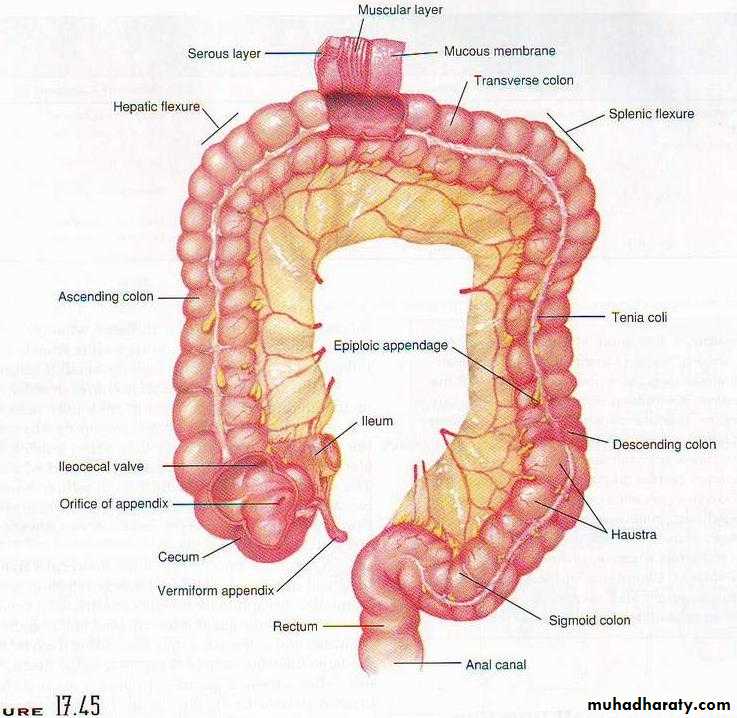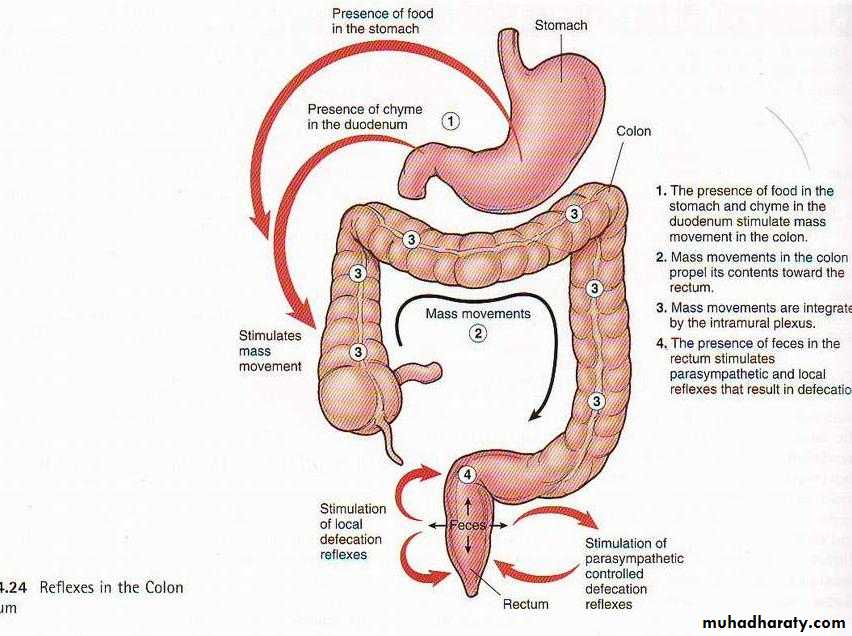Large Intestine (Colon)LEC.10 Dr. Rajaa Ahmad
The diameter of the colon is greater than the Small intestine its length is 110 cm. in living adults and 150cm in autopsy.
The fibers of the external muscular layer are collected in 3 longitudinal bands (teniae coli).
The wall of the colon form out pouching (haustra) between the tenia.
The mucosa has no villi; the epithelial cells contain almost no enzymes.
They consist mainly of mucus cells that secrete mucus only. Solitary lymph follicles are present in the cecum and appendix.
The principal functions of the colon are
• (1)Absorption of water and electrolytes from the chyme to form solid feces and• (2) storage of fecal matter until it can be expelled.
• The proximal half of the colon, is concerned principally with absorption, and the distal half with storage. Because intense colon wall movements are not required for these functions, the movements of the colon are normally very sluggish.
• Secretions of the large Intestine
• 1. Mucus secretion: epithelial cells and crypts secrete large quantities of mucus; it’s secretion is regulated by:
• 1) Direct tactile stimulation of the mucosal cells crypts.
• 2) Local nervous reflexes to the mucus cells in the crypts.
• 3) Stimulation of the pelvic nerves which carry the parasympathetic innervations to distal 1 / 2 – 2/3 of the large intestine and cause marked increase in the secretion of the mucus. Emotional disturbances lead to extreme parasympathetic stimulation which increase secretion and motility.
• Functions of the mucus in the large intestine:
• It protect the wall against excoriation.• It provide the adherent medium for holding fecal material.
• It protects the wall from the great amount of bacterial activity that takes place inside the feces.
• Mucus + HCO3 PH =8.0 provide a barrier to keep acid formed deep in the feces from attacking the intestinal wall.
• 2. Secretion of water and electrolytes
• During enteritis, the colon, in response to irritation secrete large amount of H2O and electrolytes in addition to viscid alkaline mucus. This act to dilute the irritating factors resulting in rapid movement of feces toward the anus ( diarrhea), loss of H2O and electrolytes wash the irritant substance.• Movements of the colon
• The proximal ½ of the colon concerned with absorption and the distal ½ with storage.• The movements of the colon are normally very sluggish, this movement still have characteristics similar to the small intestine, it is divided into the following:
• Mixing movements (Haustrations)
• Propulsive movements
• 1. Mixing movements (Haustrations):
• Large circular constriction occur in the large intestine.
• About 2.5cm of the circular muscle contracts causing sometimes occlusion of the lumen of the colon.
• The longitudinal muscle of the colon (teniae coli) contract at the same time.
• Both contractions cause the unstimulated portion of the large intestine to bulge outwards in to bag like sacs called haustrations.
• These contraction reach their peak intensity in (30) seconds and then disappear in the next (60) seconds.
• They move slowly analward during their period of contraction providing propulsion of the colonic contents especially in the cecum and the ascending colon.
• 2. Propulsive Movements (Mass Movements):
• Propulsion in the colon occurs by:• 1) The slow anal ward movement of the haustral contractions.
• 2) Mass movements.
• The propulsion in the cecum and ascending colon result from the slow haustral contraction it takes (8-15 hours) to move the chyme from ileocecal valve through the transverse colon, the chyme becomes fecal in quality.
• From the beginning of the transverse colon to the sigmoid, mass movements mainly take over the propulsive role. Mass movements occur only 1-3 times/day. Mostly for about (15) minutes during the first hour after eating a breakfast.
• Mass movement: is a modified type of peristalsis characterized by the following events:
• 1) Constrictive ring occurs in the distended or irritated point in the transverse colon and then rapidly the 20 or more cms. of the colon distal to constriction loss their haustrations.
• 2) They contract as one unit forcing the fecal material in this segment down the colon.
• 3) The contraction develops progressively more forcefully for about 30 seconds and relaxation then occurs during the next 2-3 minutes before another amass movement occurs.
• 4) The whole series of mass movements persists for only 10-30 minutes. They return a half day or a day later, when they have forced a mass of feces into the rectum, the desire for defecation is felt.
• Mass movement is facilitated by:
• Gastrocolic and Duodenocolic reflexes initiate mass movement, they result from distention of the stomach and duodenum, they are conducted through the extrinsic nerves when extrinsic nerves are removed, these reflexes do not occurs at all.• Irritation of the colon can initiate intense mass movement. In (ulcerative colitis) mass movement persist all the time.
• Intense stimulation of the parasympathetic nervous system or over distention of a segment of the colon mass movements occurs.
Most of the time, the rectum is empty of feces. This
results partly from the fact that a weak functionalsphincter exists about 20 centimeters from the anus
at the juncture between the sigmoid colon and the
rectum. There is also a sharp angulation here that contributes additional resistance to filling of the rectum.


